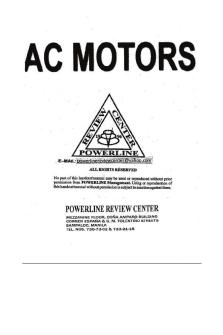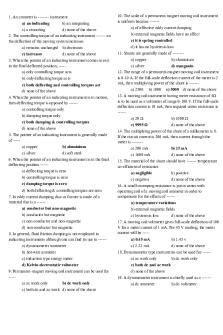Villamos energetik 1. / Electrical Power Engineering 1. - Protection against electric shock PDF

| Title | Villamos energetik 1. / Electrical Power Engineering 1. - Protection against electric shock |
|---|---|
| Course | Villamos energetika 1. |
| Institution | Pécsi Tudományegyetem |
| Pages | 6 |
| File Size | 361.6 KB |
| File Type | |
| Total Downloads | 2 |
| Total Views | 136 |
Summary
Elmer György angolnyelvű előadás anyaga...
Description
7.4
Protection against electric shock
Requirements of the protection of humans and the animal stock against electric shock are defined by the standard HD 60364-4-41:2007 Low voltage electrical installation. Part 4-41. Protection for safety. Protection against electric shock. Protection against electric shock is composed by two main parts which are as follows: - Basic protection – protection from shock under normal – faultless – conditions is provided by basic protective provisions referred to as ‘basic protection’. - Fault protection – when the installation is in a single fault condition the shock protection is provided by fault protective provisions referred to as ‘fault protection’. Basic protection serves for protection against accidents caused by electric shock when getting into contact with normally live parts of electric equipment. Fault protection serves for protection against accidents caused by electric shock when getting into contact with normally not live parts of electric equipment normally however which can become live in case of a single fault – chassis contact – of the equipment. Protective measure shall consist of: - An appropriate combination of a provision for basic protection and an independent provision for fault protection, or - an enhanced protective provision which provides both basic protection and fault protection, like e.g. reinforced insulation. 7.4.1 Basic protection Basic protection can be formularized as protection against electric shock in case of normal – faultless – state of the electrical equipment. Fault protection can be formularized as protection against electric shock in case of a single fault. This fault can be the chassis contact. Auxiliary protective measures can be necessary for a certain method of protection under special circumstances or environments. If one or more conditions of the given method of protection can not be ensured, then auxiliary measures have to be done to guarantee the required level of safety. Basic protection separates the normally live part of the electric equipment from the normally not live parts of it and prevents live – dangerous – parts to be touched by unauthorized persons by applying one of the following measures: - Basic – working – insulation of active parts; - protective earthing, grounding; - protective enclosure. 7.4.2 IP protection level Requirements of degrees of the basic protection is defined by the standard EN IEC 60529:2015 Degrees of protection provided by enclosures (MSZ 806-1:1976).
The IP degree of protection informs about the level of protection of the electrical equipment against intrusion of body part like hands and fingers, dust, accidental contact and water.
Degree of protection of an electrical equipment is marked with IP xy. IP is the abbreviation of International Protection followed by two digits. The first digit (marked with ‘x’ above) indicates the level of protection against access to hazardous parts and intrusion of foreign material like dust. The second digit (marked with ‘y’ above) indicates the level of protection against the intrusion of water. Detailed description of the first digit (protection against intrusion of solid bodies): 0 - No protection, live parts can be touched freely and foreign bodies can get into contact with them; 1 - live parts can not be touched with the back of the hand; 2 - live parts can not be touched with fingers; 3 - live parts are not accessible with wires with diameters up to 2.5 mm; 4 - live parts are not accessible with wires with diameters up to 1 mm; 5 - ingress of dust is not entirely prevented, but it do not interfere with the operation of the equipment; 6 - no ingress of dust. Detailed description of the second digit (protection against intrusion of solid bodies): 0 - no protection against the intrusion of water; 1 - protection against water dripping vertically; 2 - protection against water dripping at an angle of 15 to the vertical; 3 - protection against water dripping at an angle of 60 to the vertical; 4 - protection against water splashing at any angle; 5 - protection against water jet at any angle; 6 - protection against powerful water jet at any angle (or against water wave); 7 - protection against intermittent immersion into water; 8 - protection against durable immersion into water. Meaning of the first digit is illustrated in Table 7.4. Table 7.4. Illustration of the first digit of the IP protection code Degree of protection
Dimension
Intrusion of foreign bodies
Access of humans
IP1X
50 mm
back of the hand
IP2X
50 > 12,5 mm
finger
IP3X
12.5 > 2.5 mm
tool
IP4X
2.5 > 1.0 mm
wire
IP5X
protected against dust
wire
IP6X
dust resistant
wire
Meaning of the second digit is illustrated in Figures 7.2 to 7.6
a)
b)
Fig. 7.2. Equipment protected against the intrusion of water drops dripping vertically ( a) and at an angle of 15 to the vertical (b)
Fig. 7.3. Equipment protected against the intrusion of water drops dripping at an angle of 60 to the vertical
Fig. 7.4. Equipment protected against the intrusion of water splashing at any angle
a)
b)
Fig. 7.5. Equipment protected against water jet at any angle (a) protection against powerful water jet at any angle (or against water wave) ( b)
a)
b)
Fig. 7.6. Equipment protected against intermittent (a) and durable immersion into water (b) Symbols marking the second digit are illustrated in Table 7.5. Table 7.5. Symbols illustrating the second digit Degree of protection
Dimension
IPX1
Protected against dripping water
IPX2
Protected against water dripping at an angle of 15
IPX3
Protected against water dripping at an angle of 60
Intrusion of water
IPX4
Protected against splashing water
IPX5
Protected against water jet
IPX6
Protected against powerful water jet (water wave)
IPX7
Protected against intermittent immersion into water
IPX8
Protected against durable immersion into water
Electrical equipment with degree 6 are intended for the use on boards of ships. In case of degree 7 the equipment can be immersed into water e.g. for cleaning. The protection of contactors and many other devices mounted into switch or control cupboards is in general IP 20. This means that their live parts can not be touched with fingers but water can intrude themselves. As a mater of course some pairs of numbers are excluded, like IP18 can not exist and some pairs of numbers are obvious, like IP 68 the degree of protection of a plunger pump. If the degree of protection of one of the two kinds is not identifiable or indifferent, than it is marked with X, e.g. IP X2. Further letters can be appended to provide additional information related to the protection of the device: f - oil resistant; H - high voltage equipment; M - device moving during water test (e.g. its rotor); S - device standing still during water test (e.g. its rotor); W - needs extra protection in case of certain weather conditions. A part of the basic protection is the enclosure of the equipment. According to the standard EN 60529:2001 the enclosure is the part of the equipment which protects the equipment against certain external impacts and direct access to live parts of it, i.e. it composes a part of the basic protection. Tasks of the enclosure are - the protection of humans, living things against access to the dangerous parts within the enclosure; - the protection of the equipment inside the enclosure against - the intrusion of foreign bodies, materials; - the harmful effects of water; - mechanical shocks; - corrosion, corrosive solutions; - living things, like molds, worms, rodents, etc.; - sunshine; - frost; - explosive media.
7.4.3 Protection against external mechanical impacts In this case the electrical equipment is protected, namely against external mechanical impacts. The standard IEC 62262:2002 Degrees of protection provided by enclosures for electrical equipment against external mechanical impacts (IK code) defines the IK code system describing the level of protection of the electrical equipment against external mechanical impacts. The IK code and the energy of the impacts are listed in Table 7.6. Table 7.6. IK code and the corresponding impact energy IK code 01 02 03 04 05 06 07 08 09 10
Energy of the impact (joule) 0,14 0,2 0,35 0,5 0,7 1 2 5 10 20
References [1] [2]
MSZ 1600-1; 54/2014 OTSZ – Országos tűzvédelmi szabályzat (National Fire Protection Regulation), Budapest, 2014;...
Similar Free PDFs

ELECTRICAL POWER UTILIZATION NOTES
- 171 Pages

AC Motors101 Electrical Engineering
- 17 Pages

Electrical engineering - Wikipedia
- 18 Pages

Badri Ram Power System Protection
- 578 Pages

Book - Power system protection - Anderson
- 1,313 Pages

Electrical Phoresis Part 1
- 4 Pages

Electrical power systems Das More
- 483 Pages
Popular Institutions
- Tinajero National High School - Annex
- Politeknik Caltex Riau
- Yokohama City University
- SGT University
- University of Al-Qadisiyah
- Divine Word College of Vigan
- Techniek College Rotterdam
- Universidade de Santiago
- Universiti Teknologi MARA Cawangan Johor Kampus Pasir Gudang
- Poltekkes Kemenkes Yogyakarta
- Baguio City National High School
- Colegio san marcos
- preparatoria uno
- Centro de Bachillerato Tecnológico Industrial y de Servicios No. 107
- Dalian Maritime University
- Quang Trung Secondary School
- Colegio Tecnológico en Informática
- Corporación Regional de Educación Superior
- Grupo CEDVA
- Dar Al Uloom University
- Centro de Estudios Preuniversitarios de la Universidad Nacional de Ingeniería
- 上智大学
- Aakash International School, Nuna Majara
- San Felipe Neri Catholic School
- Kang Chiao International School - New Taipei City
- Misamis Occidental National High School
- Institución Educativa Escuela Normal Juan Ladrilleros
- Kolehiyo ng Pantukan
- Batanes State College
- Instituto Continental
- Sekolah Menengah Kejuruan Kesehatan Kaltara (Tarakan)
- Colegio de La Inmaculada Concepcion - Cebu








